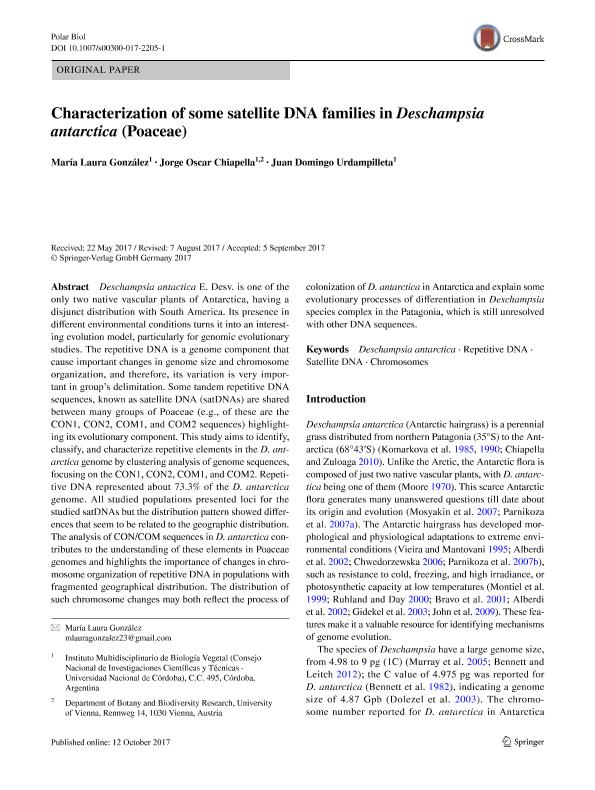Mostrar el registro sencillo del ítem
dc.contributor.author
González, María Laura

dc.contributor.author
Chiapella, Jorge Oscar

dc.contributor.author
Urdampilleta, Juan Domingo

dc.date.available
2018-01-16T17:53:03Z
dc.date.issued
2017-10
dc.identifier.citation
Urdampilleta, Juan Domingo; Chiapella, Jorge Oscar; González, María Laura; Characterization of some satellite DNA families in Deschampsia antarctica (Poaceae); Springer; Polar Biology; 10-2017; 1-12
dc.identifier.issn
0722-4060
dc.identifier.uri
http://hdl.handle.net/11336/33434
dc.description.abstract
Deschampsia antactica E. Desv. is one of the only two native vascular plants of Antarctica, having a disjunct distribution with South America. Its presence in different environmental conditions turn it into an interesting evolution model, particularly for genomic evolutionary studies. The repetitive DNA is a genome component, that cause important changes in genome size and chromosome organization, and therefore its variation is very important in group?s delimitation. Some tandem repetitive DNA sequences, known as satellite DNA (satDNAs) are shared between many groups of Poaceae (e.g. of these are the CON1, CON2, COM1 and COM2 sequences) highlighting its evolutionary component. This study aims to identify, classify and characterize repetitive elements in the D. antarctica genome by clustering analysis of genome sequences, focusing on the CON1, CON2, COM1 and COM2. Repetitive DNA represented about 73.3% of the D. antarctica genome. All studied populations presented loci for the studied satDNAs but the distribution pattern showed differences than seem to be related to the geographic distribution. The analysis of CON/COM sequences in D. antarctica contributes with the understanding of these elements in Poaceae genomes and highlights the importance of changes in chromosome organization of repetitive DNA in populations with fragmented geographical distribution. The distribution of such chromosome changes may both reflect the process of colonization of D. antarctica in Antarctica and explain some evolutionary processes of differentiation in Deschampsia species complex in the Patagonia, still unresolved with other DNA sequences.
dc.format
application/pdf
dc.language.iso
eng
dc.publisher
Springer

dc.rights
info:eu-repo/semantics/openAccess
dc.rights.uri
https://creativecommons.org/licenses/by-nc-sa/2.5/ar/
dc.subject
Deschampsia Antartica
dc.subject
Dna Satellite
dc.subject
Genome
dc.subject
Karyotype
dc.subject.classification
Otras Ciencias Biológicas

dc.subject.classification
Ciencias Biológicas

dc.subject.classification
CIENCIAS NATURALES Y EXACTAS

dc.title
Characterization of some satellite DNA families in Deschampsia antarctica (Poaceae)
dc.type
info:eu-repo/semantics/article
dc.type
info:ar-repo/semantics/artículo
dc.type
info:eu-repo/semantics/publishedVersion
dc.date.updated
2018-01-12T19:27:13Z
dc.identifier.eissn
1432-2056
dc.journal.pagination
1-12
dc.journal.pais
Alemania

dc.journal.ciudad
Berlin
dc.description.fil
Fil: González, María Laura. Consejo Nacional de Investigaciones Científicas y Técnicas. Centro Científico Tecnológico Conicet - Córdoba. Instituto Multidisciplinario de Biología Vegetal. Universidad Nacional de Córdoba. Facultad de Ciencias Exactas Físicas y Naturales. Instituto Multidisciplinario de Biología Vegetal; Argentina
dc.description.fil
Fil: Chiapella, Jorge Oscar. Consejo Nacional de Investigaciones Científicas y Técnicas. Centro Científico Tecnológico Conicet - Córdoba. Instituto Multidisciplinario de Biología Vegetal. Universidad Nacional de Córdoba. Facultad de Ciencias Exactas Físicas y Naturales. Instituto Multidisciplinario de Biología Vegetal; Argentina. Universidad de Viena; Austria
dc.description.fil
Fil: Urdampilleta, Juan Domingo. Consejo Nacional de Investigaciones Científicas y Técnicas. Centro Científico Tecnológico Conicet - Córdoba. Instituto Multidisciplinario de Biología Vegetal. Universidad Nacional de Córdoba. Facultad de Ciencias Exactas Físicas y Naturales. Instituto Multidisciplinario de Biología Vegetal; Argentina
dc.journal.title
Polar Biology

dc.relation.alternativeid
info:eu-repo/semantics/altIdentifier/doi/http://dx.doi.org/10.1007/s00300-017-2205-1
dc.relation.alternativeid
info:eu-repo/semantics/altIdentifier/url/https://link.springer.com/article/10.1007/s00300-017-2205-1
Archivos asociados
